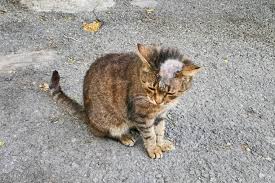Caring for Kittens: Overcoming Ringworm Challenges
Kittens are bundles of joy, bringing endless entertainment and affection into our lives. However, caring for these tiny felines comes with responsibilities, including protecting them from common health issues. One such concern is ringworm, a fungal infection that can be particularly prevalent in young and vulnerable kittens. This article will delve into understanding, treating, and preventing ringworm in kittens, equipping you with the knowledge necessary to overcome this challenge and ensure your feline friend thrives.
Understanding Ringworm in Kittens
Ringworm, despite its name, is not caused by a worm but by a fungus that infects the skin, hair, and nails. The most common culprit in cats is Microsporum canis. While it rarely poses a serious health risk, it’s highly contagious, not only to other animals but also to humans, especially children and individuals with compromised immune systems.
The classic signs of ringworm in kittens often involve circular patches of hair loss, which may be accompanied by skin irritation, scaling, and inflammation. However, it’s important to note that ringworm can present in various ways, sometimes mimicking other skin conditions. Some kittens may even be asymptomatic carriers, meaning they carry the fungus without showing any visible symptoms. This makes diagnosis challenging and underscores the importance of professional veterinary care.
Diagnosing Ringworm in Your Kitten
If you suspect your kitten has ringworm, a visit to the veterinarian is crucial. Several diagnostic methods can be employed to confirm the presence of the fungus:
- Wood’s Lamp Examination: This involves using a special ultraviolet light to examine the kitten’s fur. Some strains of Microsporum canis will fluoresce a bright apple-green color under the Wood’s lamp. However, it’s not a foolproof method, as not all strains fluoresce, and other substances can cause false positives.
- Microscopic Examination: Your veterinarian may collect hair and skin samples from the affected area and examine them under a microscope for fungal spores. This method can provide a quick diagnosis in some cases.
- Fungal Culture: This is the most reliable method for diagnosing ringworm. A sample of hair and skin cells is placed on a special culture medium to allow any fungal spores to grow. Identification of the specific fungus species is then possible. This process can take up to two weeks.
Treating Ringworm: A Multifaceted Approach
Treating ringworm in kittens typically involves a combination of approaches. Your veterinarian will recommend the best course of action based on the severity of the infection and your kitten’s overall health. The following are common treatment methods:
- Topical Antifungal Medications: Antifungal creams, ointments, or shampoos are often used to treat localized ringworm infections. Popular options include miconazole, ketoconazole, and lime sulfur dips. Lime sulfur dips can be highly effective but have a strong odor and can stain clothing and surfaces.
- Oral Antifungal Medications: For more widespread or severe infections, oral antifungal medications may be necessary. Griseofulvin, itraconazole, and terbinafine are commonly prescribed. These medications can have potential side effects, so close monitoring by your veterinarian is essential.
- Clipping the Fur: Clipping the fur around the affected areas can help improve the effectiveness of topical treatments and prevent the spread of fungal spores. Be sure to dispose of the clipped fur in a sealed bag to prevent contamination.
- Environmental Decontamination: Ringworm spores can survive in the environment for extended periods, so thorough decontamination is crucial to prevent reinfection. Vacuum carpets and upholstery frequently, and disinfect hard surfaces with a bleach solution (1 part bleach to 32 parts water). Wash bedding, towels, and clothing in hot water with bleach. Consider discarding items that are difficult to disinfect, such as cat trees and scratching posts.
Preventing the Spread and Recurrence of Ringworm
Prevention is always better than cure. Here are some tips to minimize the risk of ringworm in your kitten:
- Quarantine New Kittens: When introducing a new kitten to your household, keep it isolated from other pets for several weeks. During this time, monitor the kitten for any signs of illness, including ringworm.
- Good Hygiene: Practice good hygiene by washing your hands thoroughly after handling your kitten, especially if you suspect it may have ringworm.
- Minimize Exposure: Limit your kitten’s exposure to other animals, especially those that may have ringworm. Avoid taking your kitten to places where many animals congregate, such as boarding facilities or shelters, unless necessary.
- Proper Nutrition: A well-nourished kitten with a strong immune system is less susceptible to infections, including ringworm. Feed your kitten a high-quality diet appropriate for its age and developmental stage.
- Regular Veterinary Checkups: Regular checkups with your veterinarian can help detect ringworm and other health problems early. Your veterinarian can also provide guidance on preventative measures.
- Addressing Environmental Decontamination: Consistent cleaning and disinfection of your home, especially areas where your kitten spends most of its time, is important. Remember that ringworm spores can remain infectious for many months.
Caring For Kittens With Ringworm: A Commitment
Treating ringworm in kittens can be a challenging and time-consuming process. It requires patience, dedication, and close collaboration with your veterinarian. By understanding the nature of the infection, utilizing appropriate treatment methods, and implementing preventative measures, you can successfully overcome this hurdle and help your kitten live a happy, healthy life. Remember that consistency is key, and following your veterinarian’s instructions carefully will maximize the chances of a positive outcome and minimize the risk of recurrence. With proper care and attention, your kitten will be back to its playful self in no time.

